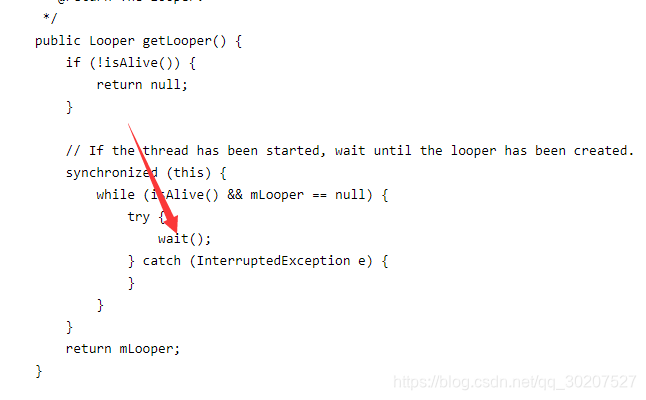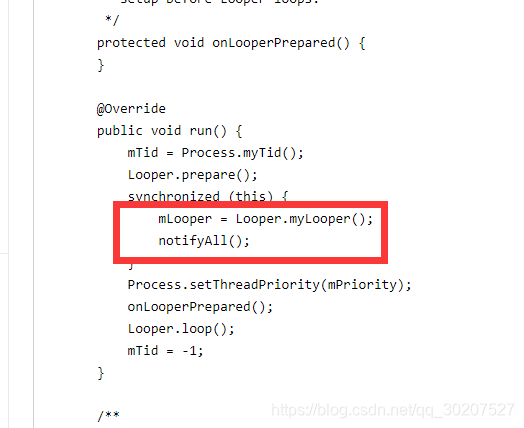一、什么是HandlerThread?
让我们贴出来HandlerThread的源码,分析Handler。
/*
* Copyright (C) 2006 The Android Open Source Project
*
* Licensed under the Apache License, Version 2.0 (the "License");
* you may not use this file except in compliance with the License.
* You may obtain a copy of the License at
*
* http://www.apache.org/licenses/LICENSE-2.0
*
* Unless required by applicable law or agreed to in writing, software
* distributed under the License is distributed on an "AS IS" BASIS,
* WITHOUT WARRANTIES OR CONDITIONS OF ANY KIND, either express or implied.
* See the License for the specific language governing permissions and
* limitations under the License.
*/
package android.os;
import android.annotation.NonNull;
import android.annotation.Nullable;
/**
* Handy class for starting a new thread that has a looper. The looper can then be
* used to create handler classes. Note that start() must still be called.
*/
public class HandlerThread extends Thread {
int mPriority;
int mTid = -1;
Looper mLooper;
private @Nullable Handler mHandler;
public HandlerThread(String name) {
super(name);
mPriority = Process.THREAD_PRIORITY_DEFAULT;
}
/**
* Constructs a HandlerThread.
* @param name
* @param priority The priority to run the thread at. The value supplied must be from
* {@link android.os.Process} and not from java.lang.Thread.
*/
public HandlerThread(String name, int priority) {
super(name);
mPriority = priority;
}
/**
* Call back method that can be explicitly overridden if needed to execute some
* setup before Looper loops.
*/
protected void onLooperPrepared() {
}
@Override
public void run() {
mTid = Process.myTid();
Looper.prepare();
synchronized (this) {
mLooper = Looper.myLooper();
notifyAll();
}
Process.setThreadPriority(mPriority);
onLooperPrepared();
Looper.loop();
mTid = -1;
}
/**
* This method returns the Looper associated with this thread. If this thread not been started
* or for any reason isAlive() returns false, this method will return null. If this thread
* has been started, this method will block until the looper has been initialized.
* @return The looper.
*/
public Looper getLooper() {
if (!isAlive()) {
return null;
}
// If the thread has been started, wait until the looper has been created.
synchronized (this) {
while (isAlive() && mLooper == null) {
try {
wait();
} catch (InterruptedException e) {
}
}
}
return mLooper;
}
/**
* @return a shared {@link Handler} associated with this thread
* @hide
*/
@NonNull
public Handler getThreadHandler() {
if (mHandler == null) {
mHandler = new Handler(getLooper());
}
return mHandler;
}
/**
* Quits the handler thread's looper.
* <p>
* Causes the handler thread's looper to terminate without processing any
* more messages in the message queue.
* </p><p>
* Any attempt to post messages to the queue after the looper is asked to quit will fail.
* For example, the {@link Handler#sendMessage(Message)} method will return false.
* </p><p class="note">
* Using this method may be unsafe because some messages may not be delivered
* before the looper terminates. Consider using {@link #quitSafely} instead to ensure
* that all pending work is completed in an orderly manner.
* </p>
*
* @return True if the looper looper has been asked to quit or false if the
* thread had not yet started running.
*
* @see #quitSafely
*/
public boolean quit() {
Looper looper = getLooper();
if (looper != null) {
looper.quit();
return true;
}
return false;
}
/**
* Quits the handler thread's looper safely.
* <p>
* Causes the handler thread's looper to terminate as soon as all remaining messages
* in the message queue that are already due to be delivered have been handled.
* Pending delayed messages with due times in the future will not be delivered.
* </p><p>
* Any attempt to post messages to the queue after the looper is asked to quit will fail.
* For example, the {@link Handler#sendMessage(Message)} method will return false.
* </p><p>
* If the thread has not been started or has finished (that is if
* {@link #getLooper} returns null), then false is returned.
* Otherwise the looper is asked to quit and true is returned.
* </p>
*
* @return True if the looper looper has been asked to quit or false if the
* thread had not yet started running.
*/
public boolean quitSafely() {
Looper looper = getLooper();
if (looper != null) {
looper.quitSafely();
return true;
}
return false;
}
/**
* Returns the identifier of this thread. See Process.myTid().
*/
public int getThreadId() {
return mTid;
}
}
从handler的源码我们知道,Handler继承Thread,所以hander实际上也是个Thread,而在Thread 的run()方法,
帮我们实现了Looper.prepare()和Looper.looper()生成looper消息的循环,HandlerThread给我们提供了和线程相关的Looper,而 Looper跟 Handler是相关联的,new Handler(HandlerThread.getLooper)可以获取线程相关的 Handler,所以HandlerThread是Handler和Thread的结合。
二、HandlerThead的使用
HandlerThead mHandlerThead = new HandlerThread("testName");
Handler mThreadHandler = new Handler(mHandlerThread.getLooper){
@handlerMessage(Message msg ){
//线程处理,在这里可以执行线程的耗时操作。
}
};
二、为什么要使用·?
让我们从一段代码去分析一下为什么要使用HandlerThread。
模拟一段从主线程向子线程通信的问题。
privare Handler mTheadHandler;
Thread mthread = new Thread(new Runnable(){
Looper.prepared();
mThreadHandler = new Handler(){
@HandlerMessage(Message msg){
}
}
Looper.loop();
});
mthread .start();
mTheadHandler.sendEmptyMessage(0x0001);
分析:以上代码,是主线程向子线程发送数据。但是会发生mTheadHandler = = null 的情况。那是因为mThread.start()可能不会马上,只运行,这要看cpu的分配情况。这使得mTheadHandler为空的情况。而HandlerThread很好的解决了这个问题。
让我们看看HandlerThead 的


从源码我们的getLooper字段,我们知道当mLooper为空的时候,通过wait()让其一直处于阻塞状态。
当HandlerThead通过start方法启动成功后,执行了run方法后,通过notify又唤醒了阻塞状态,让其继续运行下去。
实际上是通过wait()方法和 notifyall()帮我们封装解决了同步的问题。
备注:
通过thread,一样使用handler,由于Looper.looper(),内部是一直循环,如果不取消循环,线程将过一直阻塞循环下去。
所以当不用HandlerThread的时候就调用HandlerThead.quit()的方法





















 779
779

 被折叠的 条评论
为什么被折叠?
被折叠的 条评论
为什么被折叠?








